Our friends Fredrik and Nancy have spent the winter navigating the rugged and stunning coast of Baja California, Mexico. After more than a year exploring exploring Alaska’s wilds aboard their 17’ Salish Voyager, Wild Places, they set course for warmer waters—once again using this capable rowing-sailboat as both transport and tiny home. Immersed in the rhythms of the sea, they’ve explored remote beaches, observed rich marine life, and embraced the simplicity of life afloat.
This post marks the final chapter of their Sea of Cortez journey—for now. We’re grateful to share one more glimpse into their thoughtful and adventurous life on the water.
Plans Interrupted, Lessons Learned
We were all set for the last leg of our journey, the remote and spectacular coastline between Loretto and La Paz, when the saying, “Life is what happens while you are busy making other plans,” came true.
A medical emergency and a quick tour through the Mexican medical system prevented us from attempting our final goal. At first, we were devastated, but the lesson behind all the angst was to make the most of every day—and we still had a couple of weeks left

Storms, Hot Springs, and Underwater Wonders
When we departed from Loretto, winter still held a firm grip on the desert peninsula. One of the longest and strongest El Norte’s we had experienced pinned us to a now-familiar beach for five days. From our protected cove, we hiked along Danzante Island, while the wind stacked impressive breakers onto the rocky headlands of the outer shore.

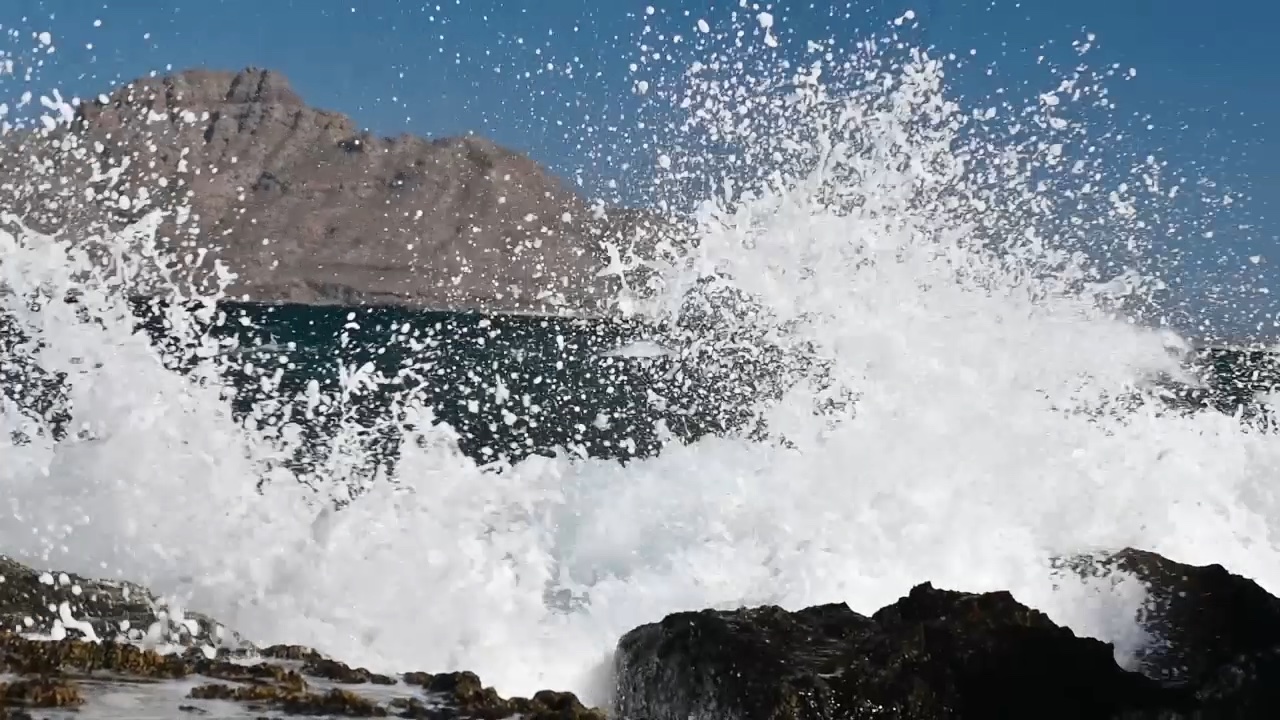
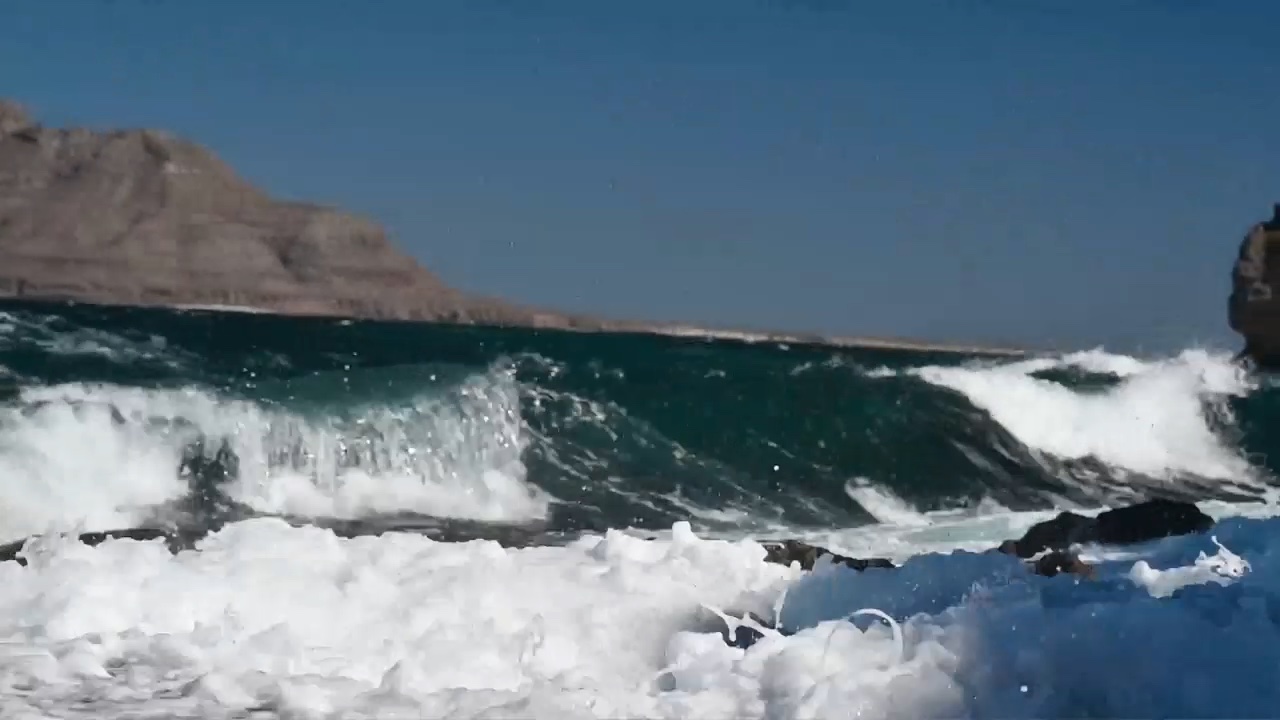
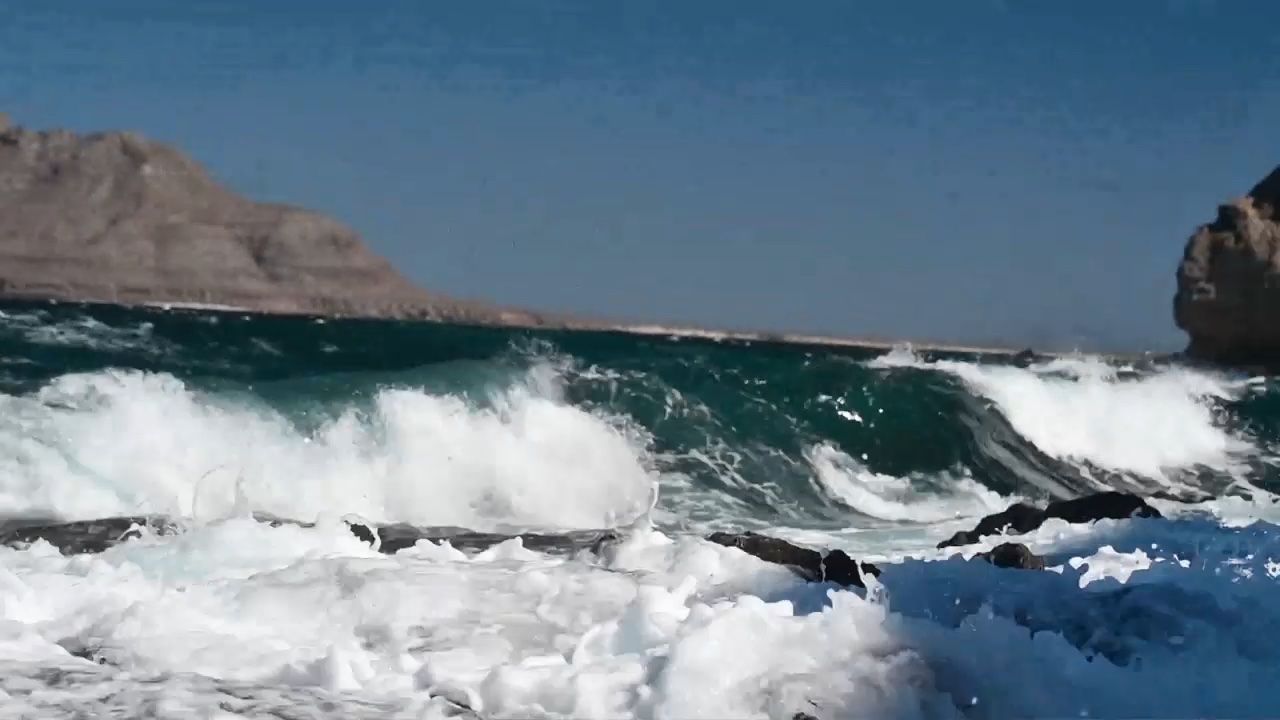

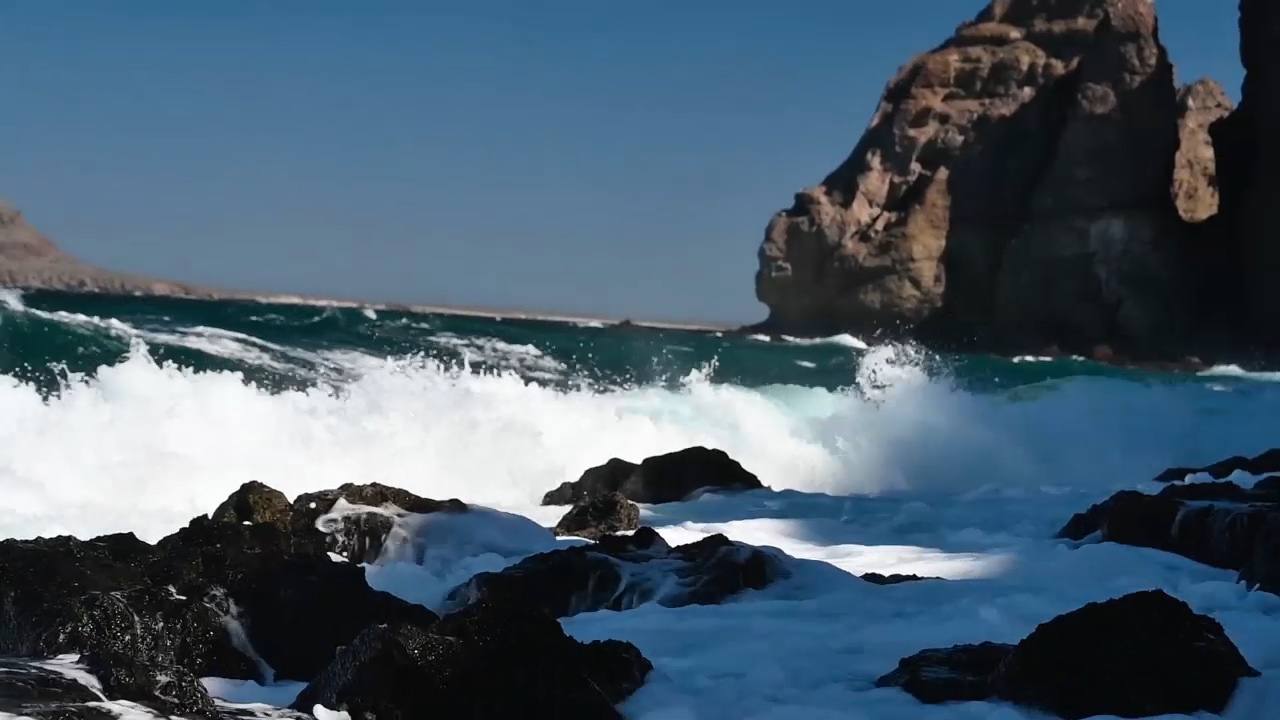
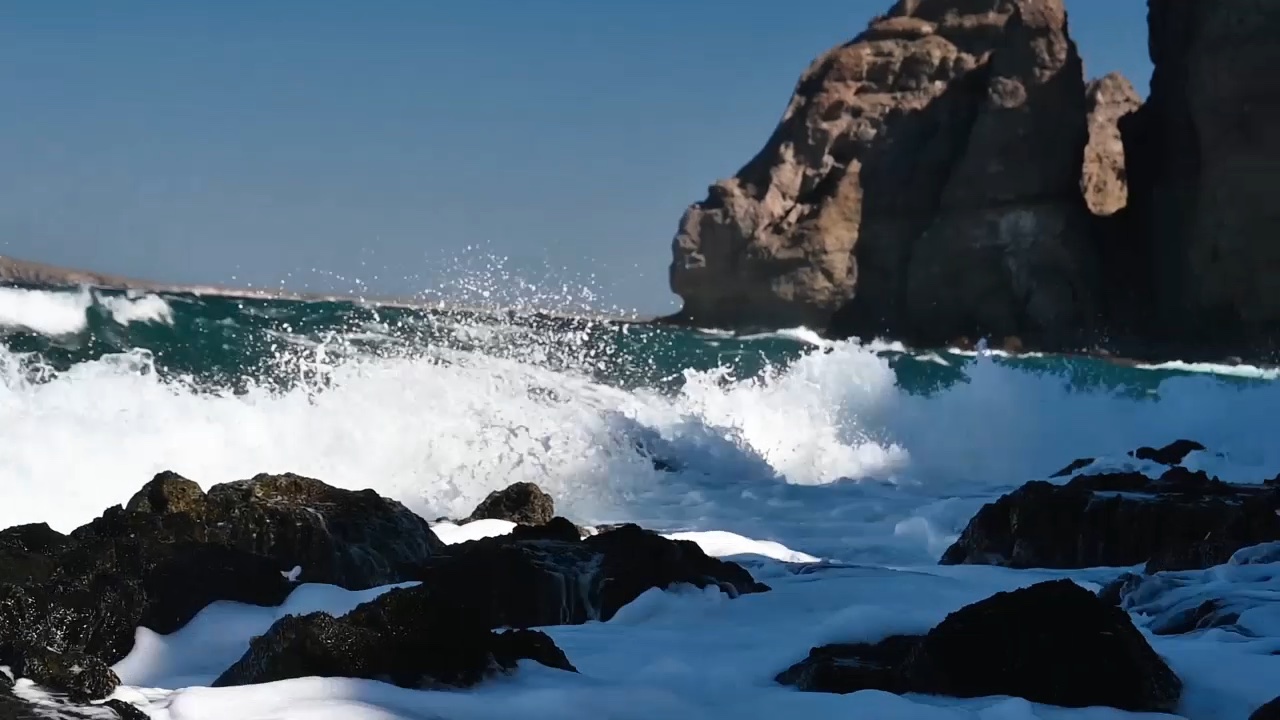
When the weather finally set us free, we headed south toward the tiny village of Agua Verde. Along the way, we stopped at a hot spring, where hot water percolated through a low-lying peninsula into a hand-built stone pool. To our amazement, there was no one else around, and the timing was perfect for a hot soak at eye level with the incoming tide.
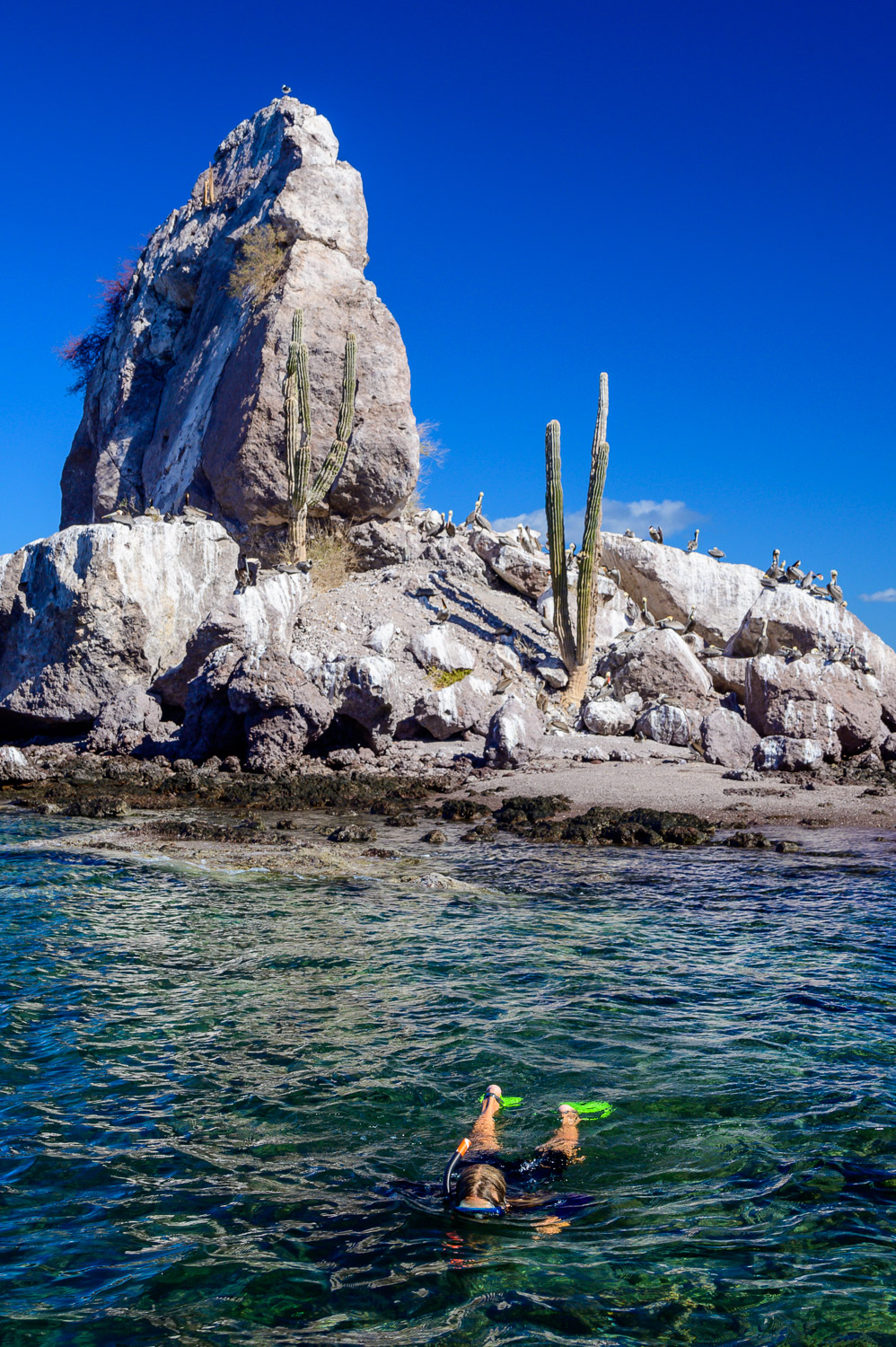
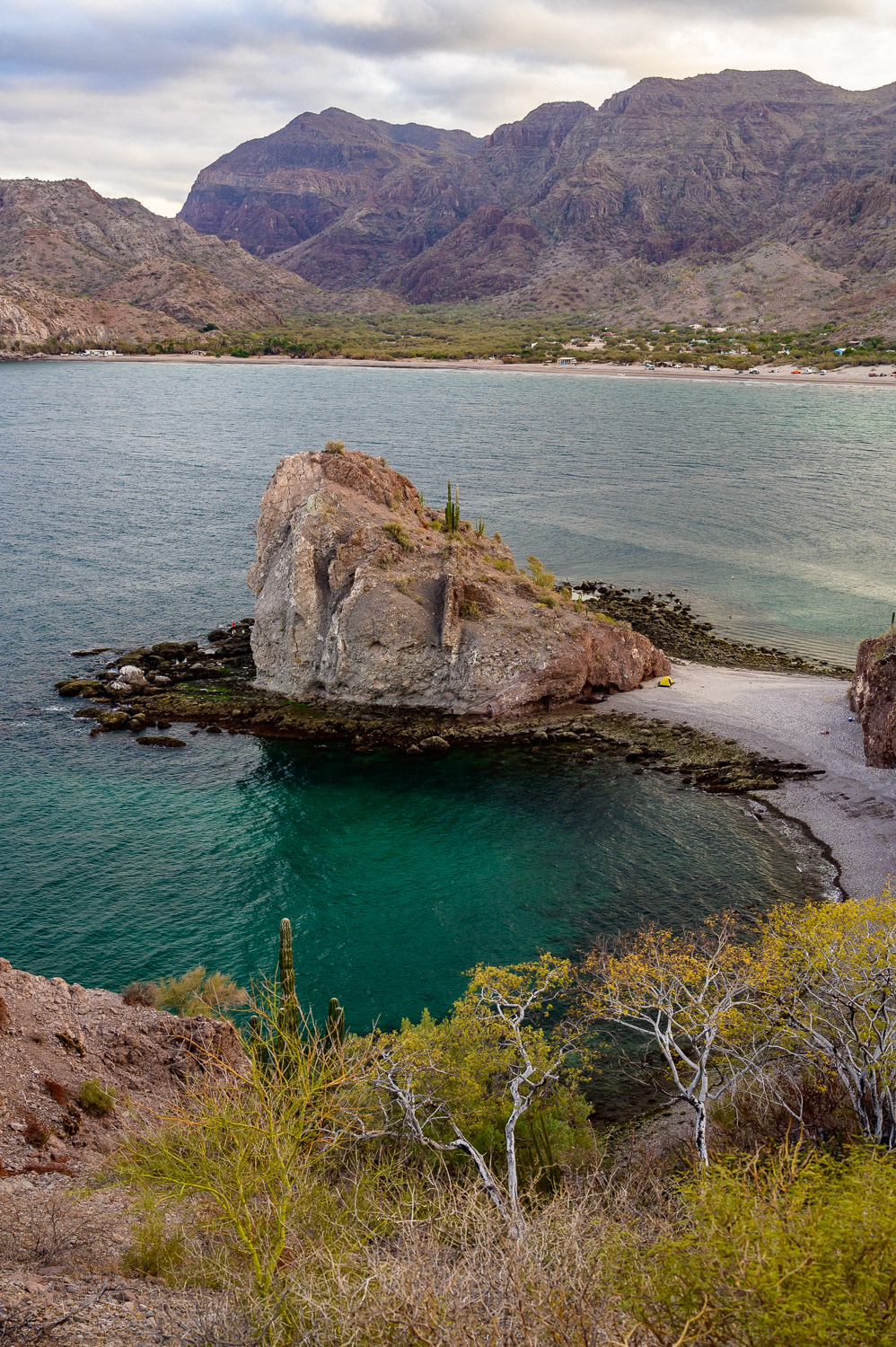
Ocean temperatures had dropped significantly in the three months we had been traveling. Gone were the days of bathtub-temperature seawater. Nevertheless, I donned my wet suit and jumped in. The waters around the peninsula were covered with calcified hunks of stony coral, as well as orange, green, and purple gorgonian fan corals, many of which I hadn’t seen before. Diversity begets diversity. Giant sea urchins and the occasional impressively spiked Crown of Thorns starfish surprised me as I floated along. I kept looking for the classically shaped and colored Chocolate chip starfish I remembered from earlier voyages, but never found one. When well chilled, I hopped back into the hot spring for a moment to warm up.
Agua Verde Adventures
“I was impressed! When I saw your boat at the point, I thought the seas out there were huge,” exclaimed the first sailboater we saw as we pulled into Agua Verde.
Indeed, we had rounded the point double-reefed with a good-sized following sea… for a 17-foot boat.
“Now I see, you just have a really small boat,” the sailor laughed.
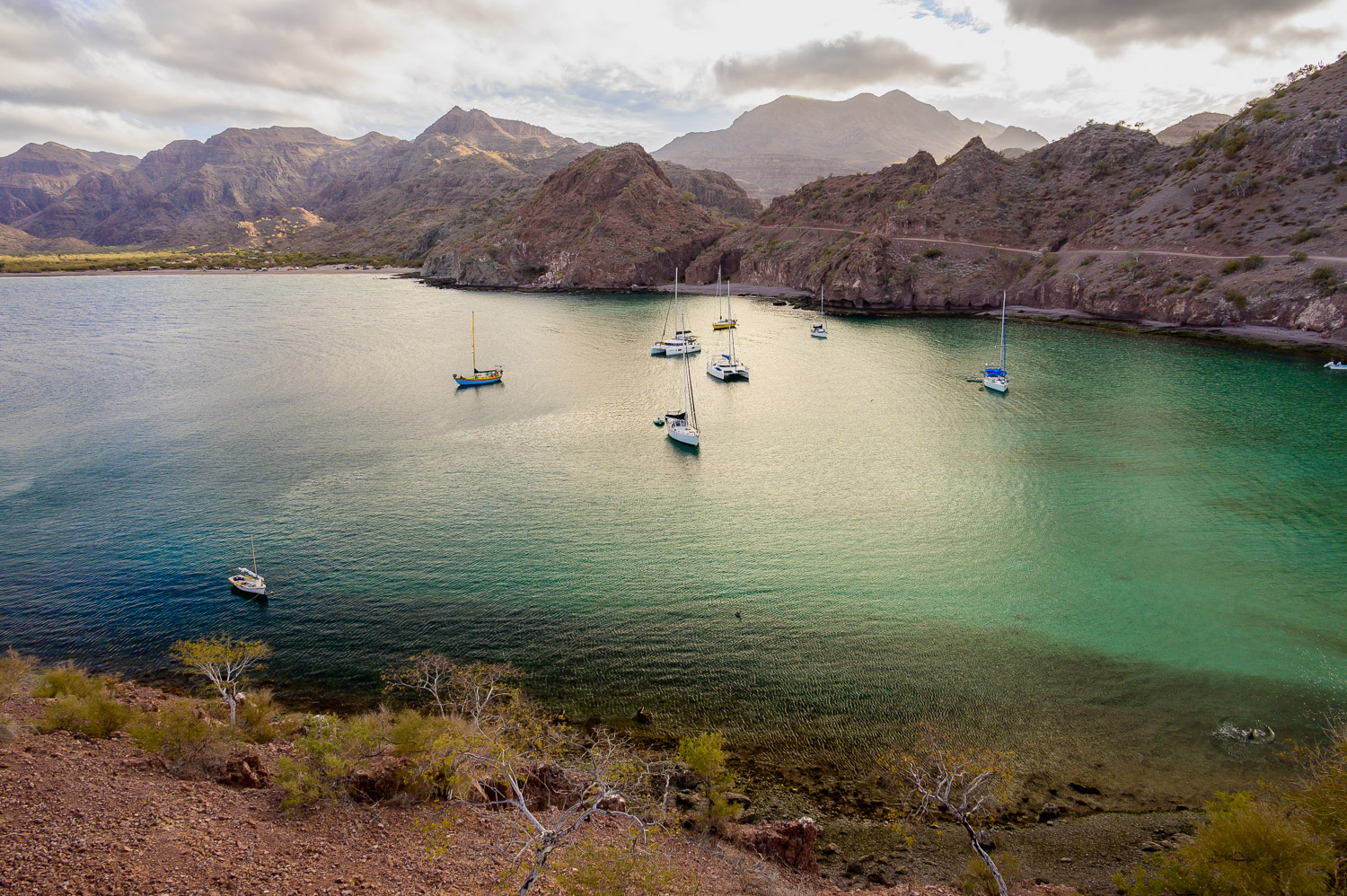
Despite being far more popular with boaters and campers than I remembered, the village of Agua Verde held its charm. At a little palapa restaurant on the beach, we enjoyed fish tacos made from Sierras we had watched the restaurant owner catch a few hours earlier.
The peninsula just outside town where we were camped turned out to be the local fishing spot. Each evening people came and filled their buckets with Barracuda, Sierra, and one of 38 different species of Grouper. One evening, our restaurant owner friends caught a two-foot-long Roosterfish with a punk rock mohawk of long colorful fins protruding from its head. Meanwhile, the gringos, (i.e. Fredrik and I) couldn’t manage to catch a fish for dinner. With typical Mexican generosity, the fisherman handed us a fish as they left, and everyone enjoyed fish tacos.
We bided our time walking long sandy beaches and visiting a cave with ancient hand prints while the north winds blew themselves out.

Hints of Spring & a Shift in Winds
The conditions we experience in the real world—the wave height and windspeed of the moment—always hold more weight in our decision-making than what is predicted on a computer model. However, the upcoming weather forecast looked enticing. Temperatures in the high seventies, with light winds… from the south… for the whole next week. This was a distinct shift from what we had been seeing for months. Could this be—we were tempted to whisper—springtime?
Afternoons with gentle downwind sailing.
Spectacular Final Days at Sea
Our final days on the water were some of the most spectacular of the trip. Mornings held the simple joy of rowing on a sea of silver glass. By early afternoon, a pleasant southerly breeze lofted us gently in the direction we were going. Neither cold nor hot, the feel of the air on our mostly bare bodies was almost imperceivable as it gently pushed us along.
Sweet mornings of rowing
The southern tip of Isla Carmen, hosted the quintessential desert island campsite, a blonde sand beach, and two lonely palm trees. The immense forms of Blue whales rose rhythmically in front of camp. First, we noticed a gigantic dark head, later the flat expanse of a broad back, and finally, the beast’s tail as it sank into the sea.
“It’s like watching an apartment building go by,” I said.
Late into the night, we listened to the deep, almost mechanical sound of whale breath.
Completing the Loop Around Isla Carmen
From there, we headed along the eastern edge of the island toward the northern tip of Isla Carmen. We hoped to complete the circumnavigation that we had been denied earlier. Our last stop before rounding the northeastern tip was a steep cobble beach. When we pulled in, gentle waves lapped at the shore. The forecast was for light to no wind for the rest of the week. We unloaded a comfortable camp.
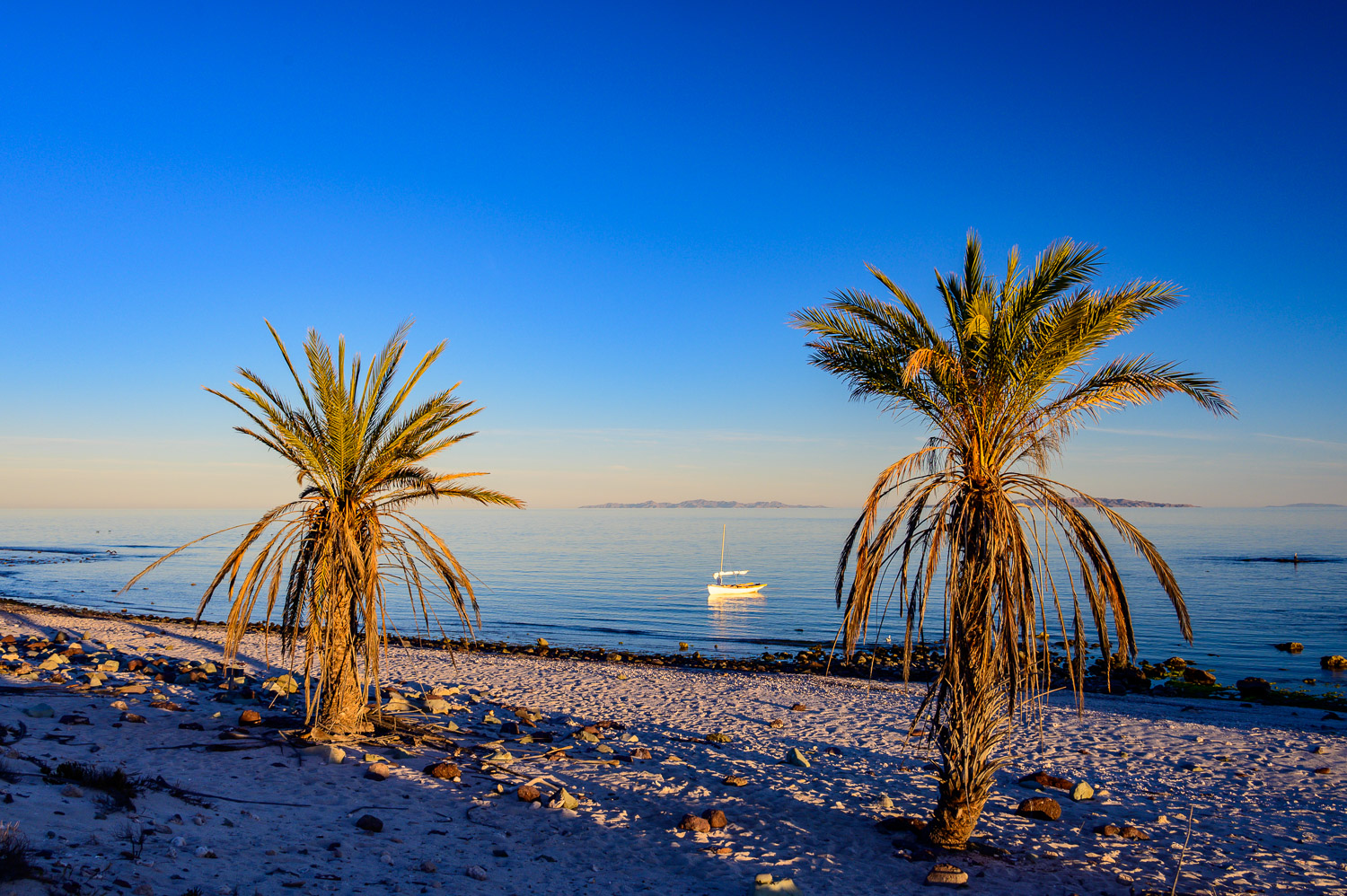
Waking early, we were surprised to find a fog bank obscuring the nearby peaks. Everything on shore was dripping with dew. Our sleeping bags were soaked. Strangely, twenty feet back into the desert, thirsty cactus remained perfectly dry. Not a breath of wind stirred. However, a good-sized surf was breaking on our cobble beach.
“Interesting, the wind must be blowing somewhere,” Fredrik said.
Reloading all the bulky items we had brought ashore the night before wouldn’t be easy. Fortunately, by this point in the trip, we had a plan.
Using the pulley system we set up most nights, we brought the boat in to just outside the surf zone. Wading in chilly water up to the crease in our hips, being careful not to slip on the baseballs and basketballs underfoot, we unceremoniously dumped our gear in a pile on board. A couple of trips each, and camp was on the boat. Fredrik jumped aboard and I pulled him out well beyond the breakers. He temporarily hooked the boat to the anchor buoy and placed the gear in the hatches. With our new fairlead and bow cleat, he was able to free the boat from the pulley system from the cockpit.
Meanwhile, I cleaned the shore anchor, coiled and stacked the ropes, and waited at the shore line for my husband to pick me up. Congratulating ourselves on the smooth efficiency of our new system, we rowed out at sunrise.
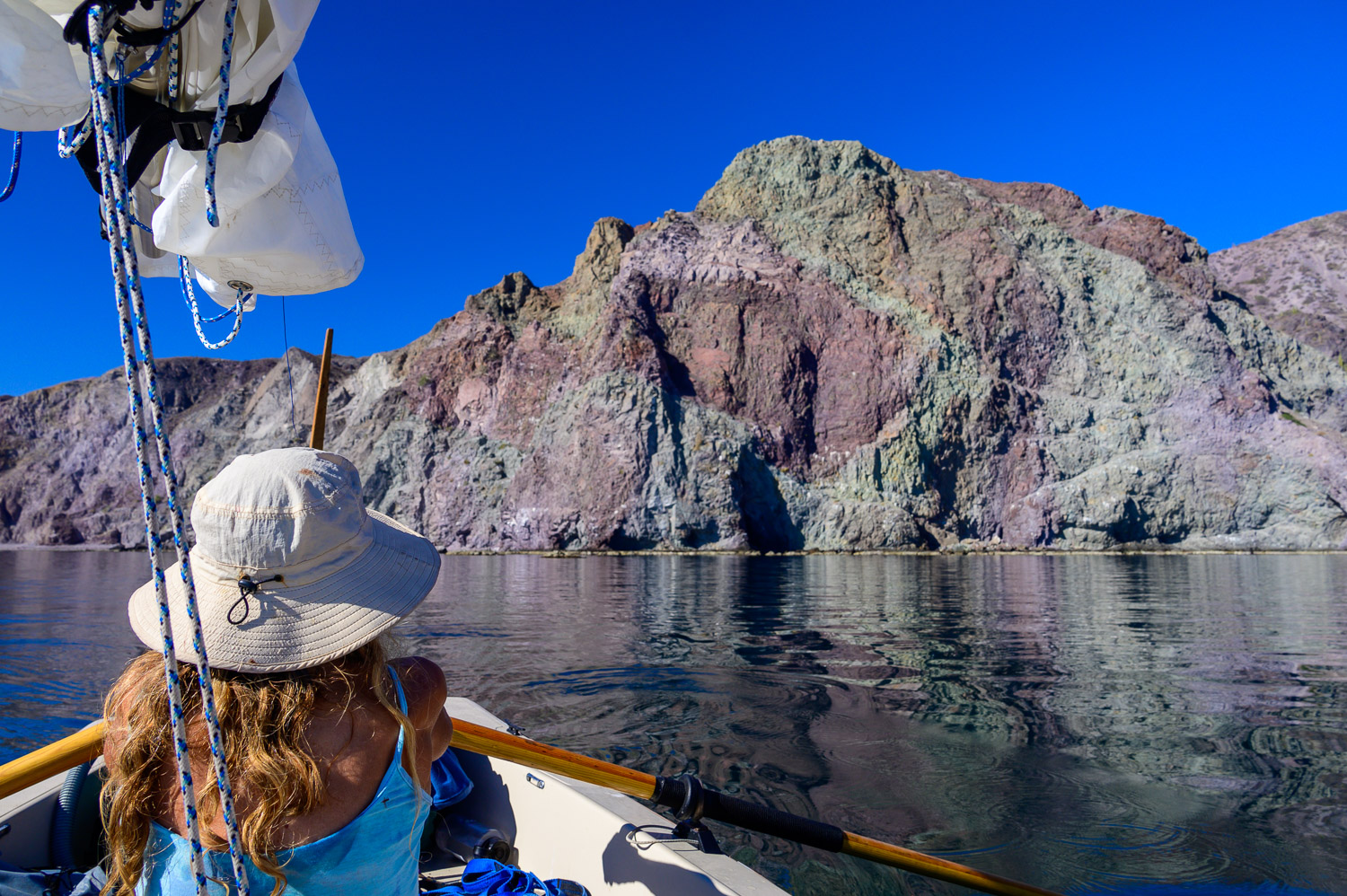
The Final Campsite & Signs of New Life
Traveling past an expanse of impressive cliffs, we counted the miles with nowhere to pull in, but were not especially concerned. The northeastern tip of Carmen, probably the most exposed point of our entire journey, was so calm and trustworthy we bobbed off the rocks trying to catch a fish. Alas, once again, to no avail.
We camped in a pretty little north-facing white sand notch. This was not the kind of place we would normally camp, no matter how lovely. If a north wind came up, we could easily be here for a week. Wonderful as that might be for people without a schedule, we had an ending date for the first time all trip. However, we had confidence the north wind wasn’t going to blow tonight.
Gone were the days of pre-dawn starts. We broke camp at leisure. We even lolled around waiting for an afternoon breeze to help with the last six-mile crossing.
Our final camp was in a tiny keyhole notch on Isla Coronado with swing room for one 17-foot boat. The entrance was so narrow and shallow that we waded Wild Places into her evening parking spot. Different from nearly every other camp we had been in, the lagoon glowed green with salt brush. A few genuine Mangrove trees lined the shore. Hundreds of gulls were preparing to nest. Fortunately, they were not yet settled and territorial with eggs to protect, so they allowed us to stay.

Signs of the coming season were everywhere. The rocky spires of Osprey nests, which had at first held only solitary, vocal, territorial males; now had couples doing home improvements and laying eggs.
One day, Fredrik discovered a writhing mass of Trumpeter fish that had “washed” ashore. Heaving one of the healthier-looking ones back out to sea, Fredrik thought he was helping. That fish wriggled back to the shore-bound mass as quickly as he could. Oh, we understood. On shore was exactly where he wanted to be.
Later, we saw hundreds of round stingrays swarming the waters of a shallow bay. The mating event of the year was about to take place.
A Bittersweet Goodbye
It is painfully obvious that oceanic life in the Sea of Cortez has diminished since 1940 when John Steinbeck and Ed Ricketts completed the expedition that inspired the book “The Log From the Sea of Cortez.” Still, springtime and baby animals fill me with hope and joy. Fredrik and I are amazed at how much we see and learn every day in this wild place.
Unfortunately, our time was up. We tucked Wild Places into a safe spot, under a well-tied-down tarp, and headed north, leaving her in Mexico…until next year.
While this marks the final installment from Wild Places in the Sea of Cortez—for now—their story continues in spirit. To follow Fredrik and Nancy’s earlier voyage through Alaska, start here, and don’t miss their reflections in back issues of Small Boats Magazine. Wherever the tides take them next, we’re honored to have shared the journey.
Learn more about the 17′ Salish Voyager.

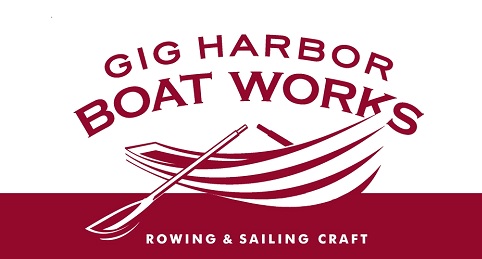
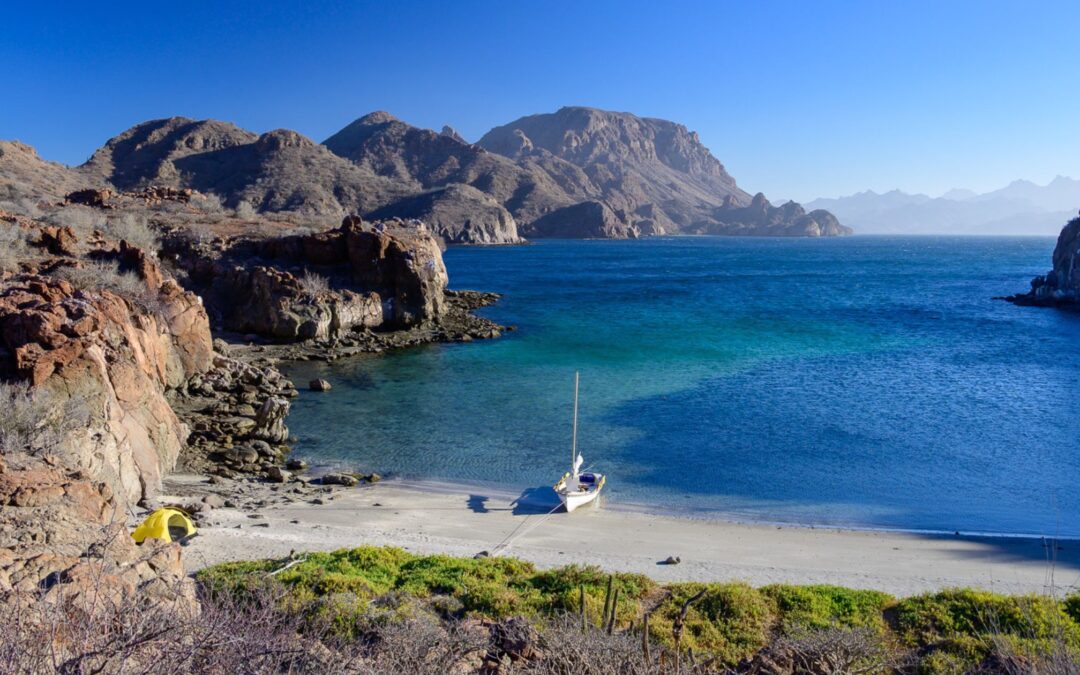
We own a Voyager in Prince Rupert and trailered down to the Baja a couple of winters ago. Our original plan was to travel Loreto to La Paz – a n expedition my pevious kayak company ran each winter. As you noted plans change, and for various reasons we did a series of mostly day trips from Loreto but have plans to do it in future.
Contact us if you are coming thru Rupert!
Woops meant day trips from Agua Verdi!